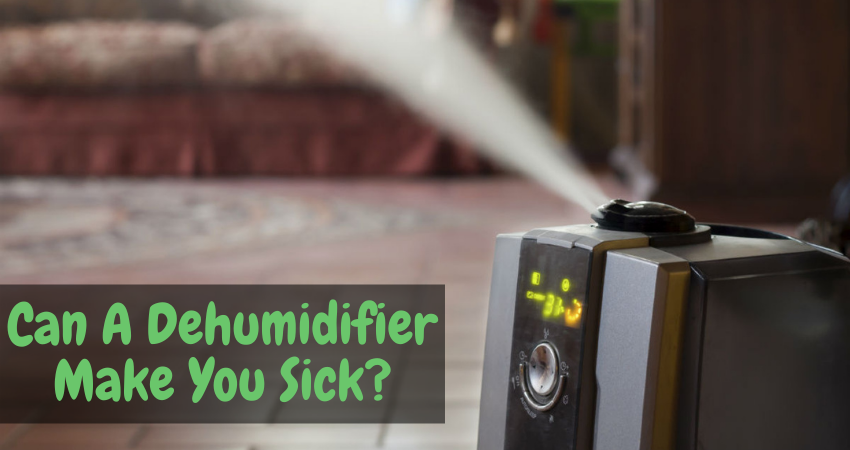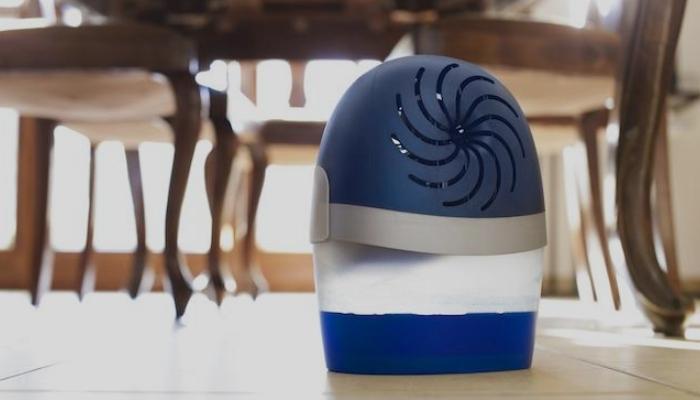Dehumidifiers are a great investment if you live in tropical regions where the humidity level can easily go up to 70% or more, causing different problems. High humidity means a higher amount of moisture in the air causes mold and mildew growth, damages floor, wall, and furniture, and may even invite different health hazards.
Thus, dehumidifiers will help you quickly get rid of these problems for a better lifestyle. However, can a dehumidifier make you sick? Well, this is a rare question but an incredibly valid one.
Although there’s no direct evidence that a dehumidifier is responsible for any health issues, running it for too long can be problematic at times. When you run the dehumidifier for too long at the highest settings, it might over-dry the air.
As the relative humidity level of the interior space falls below 40%, the drier air can cause skin irritation, sinusitis, and bathing problems. Thus, you need to know the proper method to use a dehumidifier at home for the best results.
In today’s article, we will talk about the same topic. Yes, you will learn the possibility of the dehumidifier to cause sickness, its advantages, and its disadvantages. Finally, you will also know how to use the device in interior space.
So, stick with us if you are planning to get a dehumidifier soon or aren’t getting the expected performance from the device.
Can a Dehumidifier Make You Sick?
When you install a dehumidifier at home or office, this burning question evokes in most people’s minds. “Can my dehumidifier make me sick?”

You will be delighted to know that a properly used and running dehumidifier is never responsible for human beings’ health hazards or sickness. In fact, you will love using a dehumidifier to control the humidity level during the summer.
In many states of the USA, relative humidity level often crosses 70% or more. It happens mostly in the states of Alaska, Louisiana, Florida, etc. Even during the coldest time of the year, the humidity level remains well above 50% in these states. Such high humidity increases the chance of mold and mildew growth. Also, higher moisture levels in the air will damage the floor, wall, and furniture as it can carry germs and bacteria.
Thus, a dehumidifier can help you eliminate these problems easily from home. With the device, you can easily control the relative humidity level in interior space just as you want. So, you won’t have excess moisture in the air. It relieves you from added moisture that can often cause breathing problems and respiratory issues.
Nonetheless, you must know the right method to use a dehumidifier. It is essential since a dirty dehumidifier might work oppositely. Thus, it will help develop germs and bacteria in its dirty tank reservoir. It can make you sick even without your awareness of it. Also, when you don’t maintain the dehumidifier appropriately, it will lose much of its working efficiency.
Last but not least, running the dehumidifier in the winter might cause slight sicknesses such as skin irritation and respiratory problems. It happens as in winter; the relative humidity is already low. So, running the dehumidifier in the wintertime will make the air too dry and cause you sickness. It is, therefore, suggested that you don’t run the device during the winter season.
How to Use a Dehumidifier Correctly?
Yes, a dehumidifier is a great device to control the humidity level in the indoor space and remove added moisture. Also, it helps in fighting against asthma, sinusitis, pollen, and allergies. But, you will get these top benefits of dehumidifiers only when you use them correctly.

And the first rule of thumb of using a dehumidifier properly is to know how much indoor moisture is good for your health. So, what is the healthiest humidity level for human beings?
The American Society of Heating, Refrigerating and Air-Conditioning Engineers (ASHRAE) mentions that the perfect humidity level for indoor space is around 30% to 50%. If you want a more precise reading, experts suggest keeping the indoor humidity level from 45% to 55% to enjoy the healthiest air without any dryness or excess moisture.
When the humidity level goes above 55% to 60%, the moisture becomes excess in the air. Thus, you will experience mold and mildew growth in the walls, corners, and even wooden floors. Also, excess moisture becomes the breeding ground if different viruses and bacteria. For instance, the article on the relationship between different viruses and ambient humidity levels shows that optimal humidity level slows down the spreading speed of the viruses. That’s why we see fewer cases of influenza attacks during the wintertime.
Nonetheless, some viruses become hyperactive when the humidity level becomes too high. Thus, these viruses will start spreading faster instead of slowing down their pace. Thus, you need to ensure that the dehumidifier keeps the relative humidity level of the indoor space below 60% always. As we mentioned earlier, the best idea is to maintain it from 45% to 55%.
Nonetheless, you must also keep the moisture level over 40% in the indoor space since anything below 40% of the humidity level is considered drier air. When the air becomes too dry, and its moisture presence falls below 40%, you will face skin irritation, sinusitis, and respiratory problems. Pollen, dander, and different grimes can easily spread when the air becomes too dry. Thus, you may become sick due to allergy or asthma problems when the humidity level falls less than 40%.
Long story short, always maintains the humidity level in the interior space from 40% to 60% with the dehumidifier. Ensure that it never falls below 40% and goes above 60%.
You may know about the use of home air-conditioning systems more in the following video better.
How Long Should You Run a Dehumidifier?
The next big consideration to yield the best results from a dehumidifier is to run it for the time required to work and provide you with perfectly dehumidified air. Generally, a dehumidifier needs 20 minutes to 2 hours to start dehumidifying the room interior once you turn it on in the indoor space.
This working period of a dehumidifier is pretty confusing since it only tells about the minimum time the device needs to start working. It doesn’t mean that the machine will fully remove excess moisture from the indoor space within 2 hours.
The dehumidifier will need around 4 hours to 12 hours to lower the humidity level in the optimal stage. Although the exact timing may vary due to humidity level, room size, dehumidifier size, and capacity, you can run the device for 4 to 12 hours to enjoy the perfect moisture inside the room. So, ensure that you run the machine for this period.
Of course, you may choose to run the dehumidifier for 24 hours continuously. But, we don’t find any necessity of it. Firstly, it might remove too much moisture from the air. So, the indoor space might become too dry. And this is the last thing you would want in an indoor space during the hot and humid summertime.
Secondly, when you run the dehumidifier for too long, it will increase your electricity bills. Also, you may choose to run the device during off-peak time. For instance, you can run the device from 10 PM to 8 AM at night. It will help you maintain the humidity level perfectly and ensure a peaceful and happy sleep.
Also, use a thermostat or hygrometer to measure the humidity level in the indoor space. It will help you know how long you should run the dehumidifier.
Maintain and Clean the Dehumidifier Correctly
Another key point of getting the best dehumidifying results from the dehumidifier is to keep it clean and maintained properly. It is also important to l lower the electricity bill since a dirty dehumidifier will often malfunction and result in higher utility bills.
Thus, you should check the tank reservoir of the machine and remove the water timely. That’s why we suggest you get a larger dehumidifier with a large tank reservoir. It will store more water than the machine collects from the indoor air. So, you will need to remove and drain the water from the tank reservoir less frequently. It makes the maintenance of the dehumidifier easy and convenient.
Also, you should never run the dehumidifier at higher settings for too long. It puts unnecessary stress on the machine. Also, it will remove too much moisture from the air. Thus, we suggest you run the machine at medium settings for the maximum time. It will deliver the best dehumidifying results without any issues.
You should also clean the coils at least once a year. For this, you need to disassemble the machine and clean the coil. If you are unsure, you can call an air-conditioner mechanic.
Placement of The Dehumidifier
When you want your dehumidifier to remove the excess moisture and work efficiently for the perfect living condition, you need to place the device accordingly. Yes, a lot of the dehumidifier’s performance depends on its accurate placement.

Ideally, your dehumidifier should be right at the center of your room, with adequate open-air space around it. It helps the device receive and releases the air in the surroundings easily. It will further lower the electricity bill.
Moreover, positioning the dehumidifier in a well-ventilated space reduces any chances of sickness to human beings.
Top Advantages of Dehumidifier
Dehumidifiers are great for living in warm and tropical regions. It comes with some unique benefits that you will appreciate. Its key advantages include:
- As the dehumidifier lets you control the humidity level at home, you can easily reduce mold and mildew growth. Mold and mildew are detrimental to your room’s wooden floor, furniture, wall, and corners. So, using the dehumidifier will help you control mold growth and enjoy a better interior.
- Too much moisture in the indoor space often develops a stinky and musty odor. It is truly unwanted and unhealthy. As the dehumidifier controls the moisture, it prevents musty odor development.
- Excess moisture triggers mold and mildew growth and boosts dust mites, pollen, and allergic elements in the air. It happens during the spring and summertime with added humidity in the air. The dehumidifier will help you lower the moisture level in the indoor space. So, it stops the spreading of the dust mites, pollen, and pet dander inside the room. So, you will get rid of allergies.
- Excess moisture often triggers the condensation of the moisture in indoor space. When the excess moisture is trapped inside and causes condensation, it reduces your living comfort. So, installing a dehumidifier will help you fight such problems.
- As a dehumidifier helps you keep the indoor space clean and in good humidity, it improves respiratory comfort. So, it eliminates sinusitis and asthma.
Disadvantages of Dehumidifier
Dehumidifiers aren’t all about positive vibes. It also has a few major setbacks. You need to know them to get the best dehumidifying results from the machine.
- Dehumidifiers often release slightly warm air after removing moisture from it. So, sitting too close to it for too long might cause skin irritation or a slight burning sensation.
- These devices can be noisy and irritating. Thus, we suggest you get a dehumidifier that works under 30dB noise level for comfort.
- A good and high-performing dehumidifier can be costly. So, you need to be ready to spend a good amount to get a quality and reliable dehumidifying device.
Final Words
So, can a dehumidifier make you sick? No, not at all; a dehumidifier will never cause sickness to the human being as long as you maintain and clean it properly. When the tank reservoir is clean, and you maintain the device timely, it will control the humidity level perfectly.
Lastly, always maintain the relative humidity level in your indoor space within 40% to 55% to enjoy the healthiest air. It will enhance your living comfort for sure.
